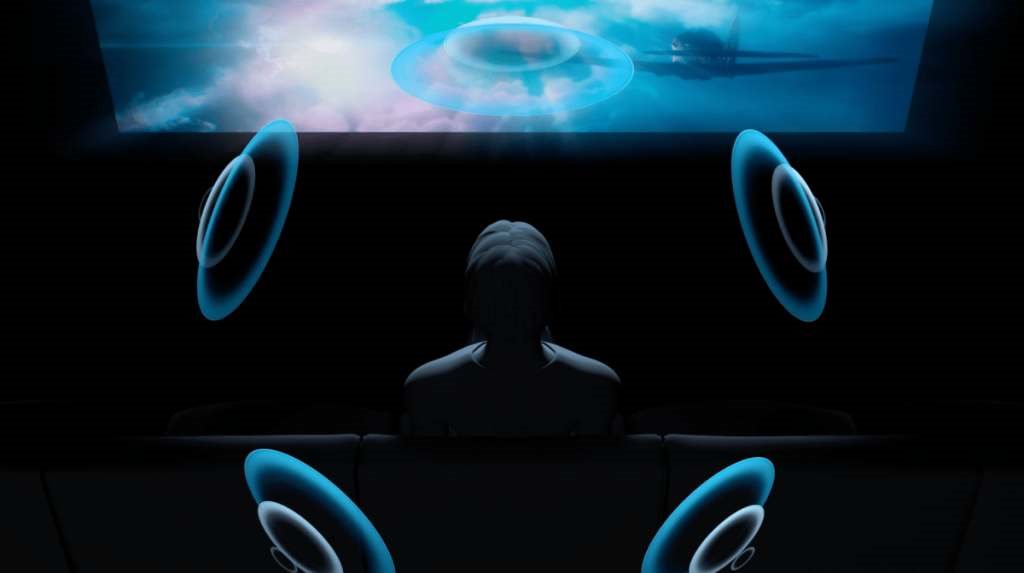Dolby Atmos - The Future of Sound, and Not Just For Home Cinemas

Dolby Atmos surround sound is often referred to as the revolution in movie sound. After a triumphant campaign across cinemas around the world, Dolby Atmos soundbars are slowly becoming an essential part of home cinemas. The transition to the latest form of what home cinema surround sound has to offer is very simple. In this article, we'll take a closer look at what Dolby Atmos technology is, how it works and what equipment you need to have to be able to get Dolby Atmos into your living room.

Dolby Atmos - CONTENTS
- What Is Dolby Atmos?
- Dolby Atmos and One Data Stream
- Sound Is Treated as an Object in Dolby Atmos
- What Does Dolby Atmos Sound Like and what Are the Differences from Earlier Technologies?
- Dolby Atmos vs. Dolby Surround
- Dolby Atmos at Home
What Is Dolby Atmos?
Dolby Atmos is a 3D object-based surround sound technology. The technology works with a more precise distribution of sound in space. This is done both through the use of more channels through which the sound is distributed (including ceiling speakers, which add a previously unknown feeling of height) and the way the sound is mixed. The larger number of channels allows for a notional division of the sound into multiple separate components. So one channel might contain gunfire, another might contain the sound of gun mechanics - previously they would sound from one point, but in reality they don't logically sound from one point. With Dolby Atmos technology, the placement of sound in space is significantly more accurate.
Dolby Atmos and One Data Stream
Another technological advance and advantage of Dolby Atmos is that the audio signal is carried by a single data stream and is no longer pre-divided into separate channels that must be matched by the sound system. An example of such an inconsistency would be the use of five-channel mix on classic stereo speakers. In such cases, the sound is not as good as it should be. It is usually depleted of some components that sound engineers have fixed, e.g. to the rear speakers.
Dolby Atmos does not use pre-determined sound streams. Instead, the Dolby Atmos technology allows for the sound to be sent to the appropriate channels by the decoder based on the setting and the specific space. The sound ultimately feels more realistic and adapts better to the speaker system you have at home. The result is a better sound quality that gives the viewer a much better opportunity to immerse themselves in the film and its atmosphere. As you can see from the above, the speakers are not that important for Dolby Atmos. The key is a system that can adapt the sound to a specific setup.
Dolby Atmos technology was introduced by Dolby Laboratories in 2012, and interestingly, movie audiences first heard it during screenings of Pixar's Brave. However, the technology has found its use not only in film scoring. There are also recorded music albums on the market in this format.
The now common standard loudspeaker sets of 5.1 or 7.1 can be enhanced by Dolby Atmos by creating additional smaller "atmospheric" speakers that can be placed virtually anywhere - on the ceiling, behind the screen, at different heights around the perimeter of the room, etc. According to Dolby, Atmos audio can be sent to up to sixty-four separate tracks. Each speaker can sound completely different from its neighbour. This makes it possible to create a truly realistic and immersive sound.

Sound Is Treated as an Object in Dolby Atmos
We have used the term "object technology"earlier in this article to refer to Dolby Atmos. What do we mean by the adjective object? Put simply, objects are those elements of the entire sound mix that are not bound to the specific space in which the sound is played. Usually music and dialogue are "fixed". They form the basis of the sound mix and their fixed positioning is an important landmark for the viewer. Everything else - the sound of the rain, the bustle of a city street or the roar of the sea waves - becomes the aforementioned sound object, whose position is not determined by the position of the loudspeaker, but by the so-called. Metadata. This is structured data, carrying information about the primary data. The simplest example is a cataloguing record in a library: The book listed on the shelf is the primary data, and is described on the cataloguing slip using structured data such as title, author, genre, ISBN or location.
Dolby Laboratories was founded in 1965 by Ray Dolby. Today, it is one of the world's leading sound technology companies. Its logo can be found in practically every cinema today. And yet, the company does not manufacture specific equipment, it only sells licenses to use its technology.
Based on the metadata, the system then calculates the position of the sound object in space, according to the specific speaker system on which the sound is played. It doesn't matter how big you want to sound or how many speakers you use. The object will always be in exactly the place the sound engineer intended it to be. This means that if you need to specify that the helicopter should fly over the viewer's head from left to right, this information is entered in the Metadata. There is no need to program each channel individually to achieve the desired sound. The information contained in the metadata is placed in the right place based on the specified algorithm.
What Does Dolby Atmos Sound Like and what Are the Differences from Earlier Technologies?
Dolby Atmos puts the listener almost directly in the centre of the action. Unlike previous technologies, the sound is not fixed to one particular direction (and a set of such individual streams creates the illusion of spatiality), but is mobile in three-dimensional space. Dolby Atmos also adds a real third dimension, height, to the sound. Earlier technologies were only able to spread the sound out in the plane. Adding a third dimension results in a more accurate spatial distribution of sound and thus a more realistic listening experience.
When it comes to the sound quality itself, Dolby Atmos creates a detailed space with a wide range of dynamics. The technology can portray whispered dialogue and an action scene full of explosions. All this without losing the orientation between the individual sounds, without the merging of individual channels.
Dolby Atmos vs. Dolby Surround
Dolby Surround is still a very common surround sound technology. In many ways, Dolby Atmos develops and deepens the viewing experience, but as a technical solution, Surround is simpler - there are still a number of home cinemas on the market at a wide range of prices, although with the proliferation of soundbars, Dolby Atmos is becoming more and more affordable. Let's compare the basic advantages and disadvantages of both systems.
Dolby Atmos
- Up to 64 channels
- Sound is moving in 3D space
- Impression of height
- Only one data stream - it is divided only by the decoder according to the system
- Multiple speakers are needed for full effect
- Not every film/medium supports Dolby Atmos
Dolby Surround
- Supported by many devices
- Easily accessible home cinema equipment
- Limited by the number of channels, 5.1 resp. 7.1
- The sound is only in the plane, it has no pitch effect
- Dividing audio into individual channels
- The channels have a fixed location
Dolby Atmos at Home
You don't have to buy dozens of new small speakers and miles of cables to be able to enjoy the full Dolby Atmos experience at home. Usually, you just need to add two or four ceiling speakers to your 5.1 or 7.1 setup to add that third dimension. Another option is to add additional smaller speakers in place of the existing ones, or a Dolby Atmos soundbar. It is also important to use a compatible amplifiers.

Also the use of increasingly popular Dolby Atmos soundbars is another interesting solution. Many soundbars are already designed with Dolby Atmos support, saving you a lot of work. So if you're planning to upgrade your system, Dolby Atmos soundbars are undoubtedly an elegant solution. And as it seems lately, this option is slowly starting to displace classic home cinemas.
Dolby Atmos is the future of sound. This technology has already found its place in cinemas around the world and is expanding into living rooms, home theatres and projectors. The purpose of Dolby Atmos is single: to surround the viewer with sound so that they feel like they are in the centre of the action.



